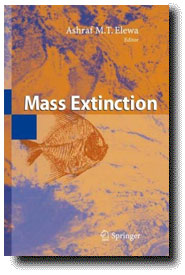
Mass Extinction
Ashraf M.T. Elewa (editor). 2008,
Springer-Verlag, Berlin Heidelburg. $169.00.
ISBN: 978-3-540-75915-7
This is a curious book. On the face of it, this appears to be an edited volume intended to provide a review of all mass extinction events (surely the title should have been in plural?). In fact it is a series of review chapters on some mass extinction events, but not all, interspersed with 2-3 page chapters, by the editor, covering the “missing” extinctions (Chapter 2 – Late Ordovician Mass Extinction, Chapter 5 – Late Devonian Mass Extinction, Chapter 6 – Late Permian Mass Extinction, and Chapter 7 – Late Triassic Mass Extinction). He shouldn’t have bothered, because these essays consist of a jumbled mixture of errors, out-of-date facts and occasionally more cutting-edge stuff. For example, the summation of the cause of the end-Permian “may be everything (eruptions, an impact, and anoxia) gone wrong at once” is typical of how unhelpful these chapters are - the book would be a lot better without them.
Even some of the more substantive chapters are only a little more informative or valuable. Congreve reviews the end-Ordovician event and its associated, short-lived ice age (Chapter 3). After a rambling introduction in which dinosaurs and mammals get a mention, we get an overview of the literature up to about 1994. Substantial, recent contributions to the debate on the cause of this extinction, including the modeling work of Lee Kump, or a lot of the new work coming out of China, are not mentioned.
The following work by Calner (Chapter 4) is a vast improvement, one of the best chapters in the volume, and provides an exhaustive overview of three Silurian extinction events covering their paleontological, sedimentological and geochemical response. Interesting nuggets here include the resurgence of microbial carbonates after every extinction event, an interesting phenomenon that is also seen after the end-Permian mass extinction.
The next event to get a substantive treatment is the end-Triassic mass extinction (Chapter 8). The main chapter is by Spencer Lucas and Lawrence Tanner, two of the main players in this field and it shows in this well-informed and balanced overview. They stress the important bias of the “compiled correlation effect” in producing an apparently more sudden crisis. This effect is caused by assuming that all the extinction losses within a stage occurred at the end of the stage when in reality they may be spread out throughout the interval. Their summation, that this crisis can be resolved into at least two discrete events and that there is no obvious extinction seen in the plant fossil record, is eminently sensible. Some may quibble with these conclusions but not me.
The succeeding Toarcian extinction event gets no mention at all, but at least it was spared one of the editor’s random data-gathering exercises. The style of chapters then changes dramatically with a study by Abdelhady of the Cenomanian/Turonian mass extinction in the Eastern Desert of Egypt (Chapter 9). There’s useful information here, but the lack of a broader regional perspective left me wondering whether a lot of the extinction losses represent local disappearances rather than truly global extinctions. The regional study style of the chapter continues with the K/T extinction (Chapters 11 and 12). Elewa and Dakrory provide a fairly incomprehensible look at the fate of planktonic foraminifers in sections from the Sinai Desert. For some reason the results are presented as two cluster diagrams when simple range charts would have been far more informative.
Finally we have a chapter on the Pleistocene megafaunal extinctions in SE Asia by Louys, which is strongly in favor of climate-driven losses rather than over-kill (Chapter 13), and a chapter on current insect extinctions by Petrakis, which includes suggested measures for conservation (Chapter 14).
If I had bought this book I would have felt short changed. Even on the first page we are told that “the break between Permian and Jurassic periods became the dividing line between the Paleozoic and Mesozoic”, and it has been padded out with essentially pointless essays. However, it is not all bad, the chapters by Calner and Lucas and Tanner are worth reading, and the Cretaceous record in Egypt gets good coverage, but it falls short of being an up-to-date synthesis of this fast-moving field.
 Reviewed
by
Reviewed
by